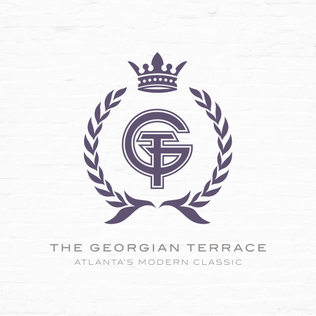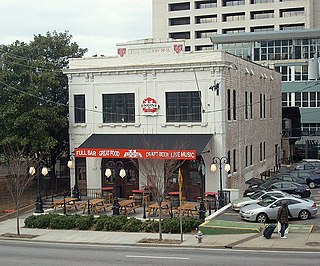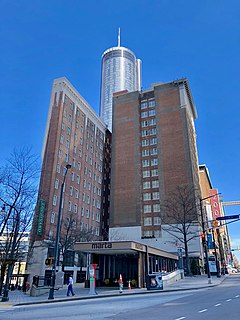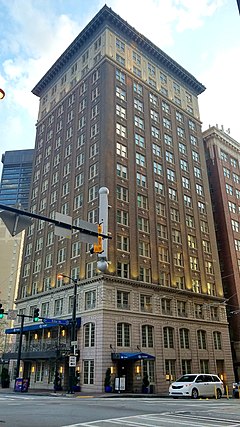
The Westin Peachtree Plaza, Atlanta, is a skyscraper hotel on Peachtree Street in downtown Atlanta, Georgia, adjacent to the Peachtree Center complex and the former Davison's/Macy's flagship store with 1,073 rooms. At 723.0 ft (220.37 m) and 73 stories, a total building area of 1,196,240 sq ft (111,134 m2) and a 187 ft (57 m) diameter, the tower is the fourth-tallest hotel in the Western Hemisphere, and the 30th tallest all-hotel building in the world.

Five Points is a district of Atlanta, Georgia, United States, the primary reference for the downtown area.

The Margaret Mitchell House is a historic house museum located in Atlanta, Georgia. The structure was the home of author Margaret Mitchell in the early 20th century. It is located in Midtown, at 979 Crescent Avenue. Constructed by Cornelius J. Sheehan as a single-family residence in a then-fashionable section of residential Peachtree Street, the building's original address was 806 Peachtree Street. The house was known as the Crescent Apartments when Mitchell and her husband lived in Apt. 1 on the ground floor from 1925 to 1932. While living there, Mitchell wrote the bulk of her Pulitzer Prize-winning 1936 novel, Gone with the Wind.

The Governor's Mansion is the official home of the governor of the U.S. state of Georgia. The mansion is located at 391 West Paces Ferry Road NW, in the Tuxedo Park neighborhood of the affluent Buckhead district of Atlanta.

The Pulitzer Prize for Photography was one of the American Pulitzer Prizes annually awarded for journalism. It was inaugurated in 1942 and replaced by two photojournalism prizes in 1968: the Pulitzer Prize for Feature Photography and "Pulitzer Prize for Spot News Photography", which was later renamed Pulitzer Prize for Breaking News Photography in 2000.

The Atlanta Fire Rescue Department provides fire protection and first responder emergency medical services to the city of Atlanta, Georgia. The department is responsible for an area of 132.6 square miles (343 km2) with over 519,000 residents. As of January 21, 2021, the Fire Chief is Rod Smith.

The following are the Pulitzer Prizes for 1947.

Arnold Hardy was the first amateur photographer who won the 1947 Pulitzer Prize for Photography.

The Hotel District is a neighborhood in Downtown Atlanta, Georgia, United States. The district's name is derived from it being the home to many hotels, one of them being the famous Westin Peachtree Plaza Hotel. The Hotel District is generally considered to be bounded by the Downtown Connector to the east, Five Points to the south, Centennial Olympic Park to the west, and Midtown to the north. The district's primary thoroughfare is Peachtree Street, which contains most of the restaurants, hotels, and office buildings. The intersection of Andrew Young International Boulevard and Peachtree Street forms the heart of the district.

William Lee Stoddart (1868–1940) was an architect best known for designing urban hotels in the eastern United States. Although he was born in Tenafly, New Jersey, most of his commissions were in the South. He maintained offices in Atlanta and New York City.

The Georgian Terrace Hotel in Midtown Atlanta, part of the Fox Theatre Historic District, was designed by architect William Lee Stoddart in a Beaux-Arts style that was intended to evoke the architecture of Paris. Construction commenced on July 21, 1910, and ended on September 8, 1911, and the hotel opened on October 2, 1911. The George C. Fuller Construction Company was contractor, and the developer was Joseph F. Gatins, Jr.

The Henry Grady Hotel was a 13-story hotel located at the corner of Peachtree Street and Cain St. in Atlanta from 1924-1972. The architect was G. Lloyd Preacher. It was named after Henry Grady, Georgia's most celebrated orator. It was built on the site of the third Georgia Governor's Mansion, previously the mansion of John H. James. After the Grady was demolished, the Westin Peachtree Plaza was built on the site.

The Winecoff Hotel fire of December 7, 1946, was the deadliest hotel fire in United States history, killing 119 hotel occupants, including the hotel's original owners. Located at 176 Peachtree Street in downtown Atlanta, Georgia, United States, the Winecoff Hotel was advertised as "absolutely fireproof". While the hotel's steel structure was indeed protected against the effects of fire, the hotel's interior finishes were combustible, and the building's exit arrangements consisted of a single stairway serving all fifteen floors. All of the hotel's occupants above the fire's origin on the third floor were trapped, and the fire's survivors either were rescued from upper-story windows or jumped into nets held by firemen.

The Majestic Hotel was built in 1898 and located at 195 Peachtree Street NW in Atlanta, between Ellis St. and Cain St.. It was a major addition to the city's hotel capacity at its completion in the 1890s. It cost between $80,000 and $100,000 to build, and was the first brick and steel fireproof construction in the city. A 1902 guidebook describes the Majestic as one of three chief first-class hotels in the city, together with the Kimball House and the Hotel Aragon. In 1927 the hotel was razed to make way for a two-story commercial structure. The site is part of the location of today's 191 Peachtree Tower.

The Hotel Aragon was a six-story, 125-room hotel at 169 Peachtree Street NE, at the southeast corner of Ellis Street in Atlanta, in what is today the Peachtree Center area of downtown. It was a major addition to the city's hotel capacity at its completion in 1892, cost $250,000, and was built and owned by George Washington Collier. It was the only major hotel in the city not adjacent to Union Station. A 1902 guidebook describes the Aragon as one of three first-class hotels in the city, together with the Kimball House and the Majestic Hotel.

The Leyden House was one of Atlanta's most historic homes. It was located on 124 Peachtree Street NE between Cain and Ellis streets.

The Fire Station No. 11 in Atlanta, Georgia, at 30 North Ave., was built in 1907. It was listed on the National Register of Historic Places in 1980.

The Carnegie Building is a historic building located at 141 Carnegie Way in downtown Atlanta, Georgia, United States. Built in 1925 as the Wynne-Claughton Building, the 12-story building was designed by architect G. Lloyd Preacher. It was designated an Atlanta Historic Building in 1990 and was added to the National Register of Historic Places in 2012.

This article is about hotels in Atlanta, including a brief history of hotels in the city and a list of some notable hotels.






















